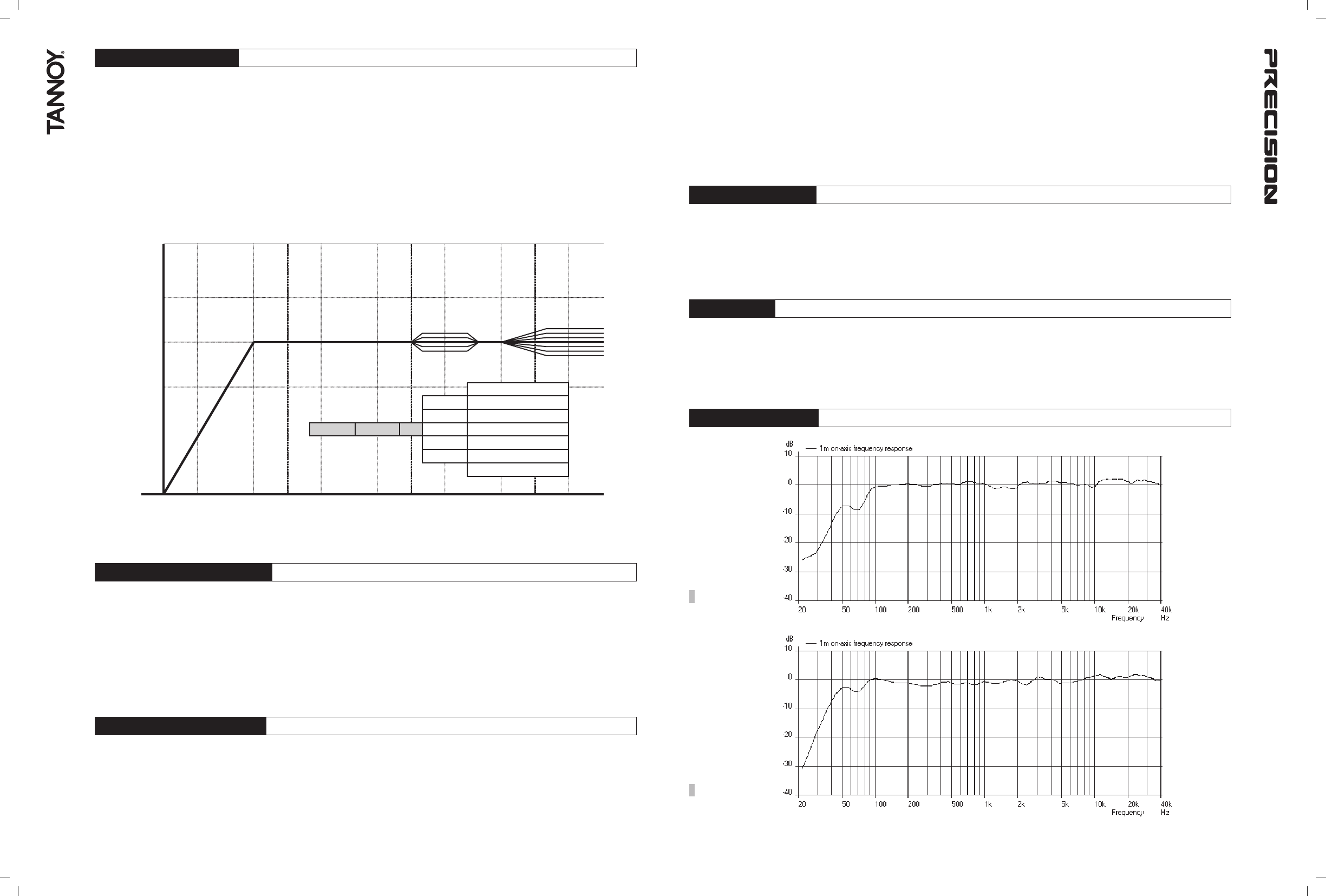
14 15
MID AND HIGH EQ SETTINGS
RT60 Decay Time: An estimation of the RT60 decay time above 1kHz within the monitoring environment will help to set the
mid and high frequency equalisation. Hard surfaces in general and particularly if close to the speakers will increase the amount
of reverberent energy to direct energy above 1kHz (RT60 above 500mS) and may justify setting the mid or high EQ (or both)
to -1dB. Absorbent surfaces in general and particularly if close to the speakers (RT60 below 200mS) will reduce the reverberant
to direct energy and may justify setting the mid or high (or both) EQ to +1dB. In both cases the LF-Q may be adjusted to
compensate the overall balance. If the monitor environment is well designed with a flat RT60 time of around 200 to 250mS
then no LF-Q, mid or high EQ should be required.
Source Material: For prolonged sessions working on bright, forward or difficult news/location material where the content of
material is being edited rather than control of the sound quality the full range of mid and high EQ can be used to prevent fatigue.
This is a matter of individual taste and the EQ can be set accordingly. Alternatively, boosting mid and high frequencies can
make decisions during editing easier with limited bandwidth material.
10Hz 100Hz 1Khz 10kHz500Hz 5kHz200Hz 2kHz 20kHz20Hz 50Hz
1 1 1 0 1 1 1 0 0 0 0 0 0 0 0 0 0 0 0 0
0 1 0 0 0 0 1 0 0 0
1 1 0 0 0 1 1 0 0 0
0 0 1 0 0 0 0 1 0 0
0 0 1 1 0 0 0 1 1 0
1 1 1 0 0 0
0 0 0 1 1 1
-10dB
+10dB
0dB re 2.8v
@ 1 metre
6.0: INSTALLING AND POSITIONING
When choosing a suitable location for the monitors, bear in mind that the physical mounting of loudspeakers can have a large
influence on performance. For best results the monitors should be mounted on a rigid structure, supported on four pads making
contacts with the laminated panel. The use of soft pads (rubber, Sorbothane, or Blu-Tak) is recommended.
Ensure that the console position does not obscure the direct sound radiation from the loudspeakers when sitting down. The
engineer and producer should have a clear, uninterrupted view of the monitor loudspeakers.
6.1: 5.1 SURROUND MONITORING
In order to ensure a uniform acoustical environment, the room should be symmetrical about the centre loudspeaker axis; room
treatments should be applied symmetrically throughout the room. Mixed "Live end/Dead end" environments should be avoided.
If the lateral speakers are positioned close to walls then the constitution of the wall surfaces should be identical.
When using either Precision 6D or 8D as the main effects speaker for the front soundstage, placement is a critical factor for
good performance.
In all cases the centre channel speaker should be placed as close to the viewing screen as possible. The viewing position when
seated determines the ideal mounting height, but in all cases this should be as close as possible to ear height, if this is not
possible the monitor should be tilted towards ear height in the mix position. The centre speaker should be positioned along the
centre axis of the picture and the left/right monitors just outside the picture, ideally the three front effects speakers would be
placed with the front baffles in line with the screen surface. If an acoustically transparent screen is used, the left/right monitors
should be placed just inside the edges of the picture. The surround speakers should be positioned at the same distance to the
mix position as the main front speakers. As the subwoofer/LFE channel only produces low frequencies it is difficult to localise
its position by ear. As a result it could effectively be situated anywhere in the room, though optimum performance will be gained
by placing the subwoofer in the same plane as the main front speakers. The LFE channel is set at a level 10dB higher than the
other channels when mixing therefore it is important to apply the same in any playback situation.
6.2: SPEAKER MOUNTING
You’ve probably got your monitors delicately balanced on your console meter bridge, or sitting on a counter top beside your
hard disc editor. Find some music with some real solid low end that you know well. Try listening to this music with the speaker
sitting directly on the mounting surface and then with it sitting on a thin piece of rubber pad. Hear a difference? Which one
sounds more like the recording should? Does one get tubby, or muddy? Depending on the type of mounting surface, you may
find it beneficial to use a thin layer of flexible material (i.e. Bluetack) beneath the enclosure. This not only absorbs some
vibration,but will help prevent the monitor from vibrating off of its mounting surface.
6.3: BASS PORTS
The Precision D monitor’s bass port is located on the back panel. You should keep the back panels at least 150mm (6") away
from the nearest wall surface to avoid an overblown bass sound. If you cannot avoid being close to the wall or if you’re using
a separate subwoofer, you may want to consider plugging the port tubes on your near-fields with a closed cell foam-rubber
plug, friction fit for a full seal. Because the ports aren’t needed if the monitor speakers are being used with a high pass filter,
you won’t be losing any bass performance and you can improve the mid-bass response by plugging the ports.
7.0: PERFORMANCE DATA
PRECISION 8D
PRECISION 6D












